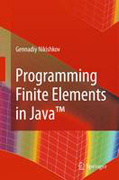
Programming Finite Elements in Java™ teaches the reader how to programme the algorithms of the finite element method (FEM) in Java™. The compact, simple code helps the student to read the algorithms, to understand them and thus to beable to refine them. All of the main aspects of finite element techniques areconsidered: finite element solution; generation of finite element meshes; andvisualization of finite element models and results with Java 3D™. The step-by-step presentation includes algorithm programming and code explanation at eachpoint. Problems and exercises are provided for each chapter, with Java™ source code and problem data sets available for the book’s webpage at springer.com/978-1-84882-971-8." Use of Java™ as a programming language provides students with easy-to-understand compact algorithm development Provision of explanation for each coding step ensures that every stage of learning is firmly cemented before proceeding to the next Source code and problem data allow students to practise what they have learnt and saves tutors time INDICE: Part I: Finite Element Formulation.- Introduction.- Finite ElementEquations for Heat Transfer.- FEM for Solid Mechanics Problems.- A Finite Element Program.- Part II: Finite Element Processor.- Finite Element Model.- Elastic Material.- Elements.- Numerical Integration.- Two-dimensional Isoparametric Elements.- Implementation of 2D Quadratic Element.- Three-dimensional Isoparametric Elements.- Implementation of 3D Quadratic Element.- Assembly and Solution.- Direct Equation Solver.- Iterative Equation Solver.- Load Data and Load Vector Assembly.- Stress Increment, Residual Vector and Results.- Elastic–Plastic Problems. Part III: Mesh Generation.- Mesh Generator.- Two-dimensional Mesh Generators.- Generation of Three-dimensional Meshes by Sweeping.- Pasting Mesh Blocks.- Mesh Transformations.- Copying, Writing and Reading Mesh Blocks.- Part IV: Visualization of Meshes and Results.- Visualizer.- Visualization Scene Graph.- Surface Geometry.- Edge and Face Subdivision.- Color Scale, Mouse Interation and Lights.- Appendices: Data for Finite Element Solver; Data for Mesh Generation; Data for Visualizer.
- ISBN: 978-1-84882-971-8
- Editorial: Springer
- Encuadernacion: Cartoné
- Páginas: 402
- Fecha Publicación: 01/12/2009
- Nº Volúmenes: 1
- Idioma: Inglés
